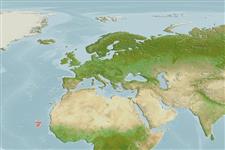klasifikasi / Names
Nama-nama umum | Sinonim (persamaan) | Catalog of Fishes(Marga, Jenis) | ITIS | CoL | WoRMS | Cloffa
>
Blenniiformes (Blennies) >
Labrisomidae (Labrisomids)
Etymology: Malacoctenus: Greek, malakos = soft + Greek, kteis, ktenos = comb (Ref. 45335); carrowi: Named for Frank Carrow, Carrow Foundation..
Environment: milieu / climate zone / depth range / distribution range
Ekologi
laut berasosiasi dengan karang; kisaran kedalaman 11 - 13 m (Ref. 98055). Tropical
Eastern Central Atlantic: Cape Verde Islands.
Size / Weight / umur
Maturity: Lm ? range ? - ? cm
Max length : 3.5 cm SL jantan/; (Ref. 98055); 3.2 cm SL (female)
deskripsi pendek
Morfologi | Morfometrik
Duri punggung (Keseluruhan (total)): 20; duri punggung lunak (Keseluruhan (total)): 10; Duri dubur 2; Sirip dubur lunak: 19. This species is distinguished by the following characters: D XX+10; A II+19; pectoral 14 soft rays; ventrals three soft rays; the length of shortest pelvic ray is more than half the length of the longest pelvic ray; lateral line scales 55-56; presence of prepectoral scales which are considerably smaller than scales on body; belly scaled except breast area; colour pattern dominated by 6 vertical bars on the body, delineated in straight vertical lines; these bands barely enter the dorsal fin; transparent dorsal fin membranes (Ref. 98055).
Collected using anaesthetic (quinaldine or clove) oil sprayed into horizontal cracks in rock faces or below large stones at about 10-13 m depth. Additional animals were seen when overturning big stones at 10-16 m and one individual was photographed at night, resting on open rock in water only 3 m deep (Ref. 98055).
Life cycle and mating behavior
Kematangan | Reproduksi, perkembang biakan | Pemijahan | telur-telur | Fecundity | Larva
Wirtz, P., 2014. A new species of Malacoctenus from the Cape Verde Islands, eastern Atlantic (Pisces Teleostei, Labrisomidae). Arquipelago. Life and Marine Sciences 31:15-20. (Ref. 98055)
Status IUCN Red List (Ref. 130435)
ancaman kepada manusia
Harmless
penggunaan manusia
informasi lanjut
Nama-nama umumSinonim (persamaan)metabolismePemangsaEkotoksikologiReproduksi, perkembang biakanKematanganPemijahanSpawning aggregationFecunditytelur-telurpekembangan telor
Umur / SaizPertumbuhanpanjang-beratpanjang-panjangukuran frekuensiMorfometrikMorfologiLarvaDinamika larvapemulihanKelimpahanBRUVS
AcuanBudidaya airprofil budidaya airStrainGenetikaElectrophoresesDiturunkanPenyakit-penyakitPengolahanNutrientsMass conversion
mitraGambarStamps, Coins Misc.Suara-suaraCiguateraKecepatanTipe renangArea insangOtolithsOtakPenglihatan / visi
Alat, peralatan
laporan khas
muat turun XML
Sumber internet
Estimates based on models
Preferred temperature (Ref.
123201): 23.9 - 25, mean 24.4 °C (based on 17 cells).
Phylogenetic diversity index (Ref.
82804): PD
50 = 0.5000 [Uniqueness, from 0.5 = low to 2.0 = high].
Bayesian length-weight: a=0.00912 (0.00399 - 0.02083), b=3.06 (2.87 - 3.25), in cm total length, based on LWR estimates for this (Sub)family-body shape (Ref.
93245).
Trophic level (Ref.
69278): 3.3 ±0.4 se; based on size and trophs of closest relatives
Fishing Vulnerability (Ref.
59153): Low vulnerability (10 of 100).
